| THE TOEPP GUNS OF ALL
TIMES
(THE SHOOTING TOPPERWEINS)
a compilation of articles written by
Norman Wiltsey for Guns & Ammo (Oct., 1961)
Col. Charles Askins for American Rifleman (Feb., 1986)
From "Famous Guns From the Winchester Collection" (1958)
Text and Images scanned by Wilbur Watje
AS LONG as there have been firearms, there have
been exceptional marksmen to whom accurate shooting has become
as instinctive as breathing. There were noted Indian fighters,
scouts, buffalo hunters and gun fighters on both sides of the
law who were almost unbelievably skillful. There were also sportsmen
who gained uncanny finesse with their firearms and marksmen and
trick shooters who made their livelihood giving awe-inspiring
exhibitions.
At about the same time that a lithe. willowy wisp of a girl, Annie
Oakley of Greenville, Ohio, came to the attention of circus and
vaudeville marksman Frank Butler, who billed himself as the "World's
Champion Rifle Shot," an Illinois sportsman, A. H. Bogardus
established a record that neither Butler nor Miss Oakley, despite
far more widespread publicity of their shooting prowess, ever
matched. On the 4th of July in 1877, Bogardus, alternating with
a pair of 12-gauge breech-loading shotguns, fired in rapid succession
at 1000 212" diameter glass balls. He is reported to have
missed only 27 of the 1000 shots, shattering one string of 303
of the glass spheres without a miss.
Twice more during the next year Bogardus turned his gun marksmanship
on 1000 glass targets. In Cincinnati, in September. 1878, he scored
981 hits. Later that same year at Bradford, Pennsylvania, he blasted
all but ten of the 1000. A year later Bogardus stretched his demonstration
to 5000 glass balls, destroying all but 156.
During this same period, neither the "Great" Frank Butler,
nor the widely publicized Buffalo Bill Cody, King of the Wild
West touring shows, made any official challenge to top Bogardus'
legitimate mark. Don't read into this comment any attempt to disparage
Cody's widely lauded marksmanship. His record, even with his initial
buffalo gun, a Springfield Model 1866 military rifle, was fantastic.
In one eighteen-month period, Cody was credited with bringing
in nearly 5000 buffalo to fulfill a meat contract he had made
with the Kansas-Pacific Railroad. A fairly well authenticated
report has it that with this same 1866 Springfield, Cody killed
two horse thieves with a single shot. The slug fired from the
rifle passed completely through one of the two thieves and downed
the second.
Cody's favorite firearms, however, were Winchesters. Of the 1873
model, he was known to have owned at least a half dozen, a number
of which are in private collections today. But once Cody left
the frontier and his touring Wild West show had added to his fame,
he was forced to resort to trick loads just as did others who
gave fast action indoor shooting exhibitions before large audiences.
Reportedly Cody's 44/40 Winchester center fire cartridges were
specially made and contained 20 grains (only a half load) of black
powder and one-quarter of an ounce of chilled shot. Cody didn't
have to resort to bird shot because he was a poor marksman but
rather because firing solid bullets with a full powder charge
in locations like Madison Square Garden would endanger audiences.
Also making a sieve of roofs wouldn't for long meet with the approval
of any building's owners.
Whether due to personal concern as to whether he could hold his
own in an official match or more probably because he was canny
enough to realize that already having an enviable reputation for
marksmanship, he had far more to lose than gain by engaging in
any competition. Cody is known only once to have shot a challenge
match.
In that fiasco reportedly he and his opponent interspersed each
gun shot with two fingers at a nearby bar so that Cody's defeat
was not a true indication of his skill nor that of his opponent,
but rather proof that his challenger was a better drinking man.
Despite her unquestioned ability as a marksman, few official Annie
Oakley records were posted. Only twice did she officially put
her highly publicized shooting skill on a block.
In 1883. a Dr. A. H. Ruth stole the nation's marksmanship limelight
when he shot at 1000 hand-thrown glass balls and broke 984 of
these with a .22 repeating rifle. Annie Oakley's press agent,
sensing the publicity value of having her shoot for a record,
persuaded her publicly to attempt to break Dr. Ruth's mark. In
1884, firing a .22 rifle under the same conditions, Annie nearly
accomplished her goal. She smashed 943 of the 1000 glass balls.
The 57 misses and failure by 31 shots to match Dr. Ruth didn't
tarnish the sheen of her reputation -- after all shooting was
still considered to be a man's sport.
That same year Miss Oakley also unsuccessfully tried to duplicate
Bogardus' feat. Rotating between three 16-gauge shotguns, "Little
Miss Sure Shot" fired at 5000 glass balls, missing 228, scoring
62 fewer hits than Bogardus had five years before but again she
gained added luster by skilled press agentry.
The shooting of glass balls, of course, should not be confused
with modern trap-shooting. Skeet target traps are adjusted to
skim a clay pigeon at the height of 15 to 20 feet for a distance
of 45 to 50 feet with the trap changing angle of throwing direction
with each shot. The clay disk shooter does not know which way
the target will soar. The old glass ball traps catapulted the
target to a height of about 35 feet for a distance of about 35
feet from the trap. Hand thrown targets simulated this same procedure.
The direction of target movement was much the same for each shot.
So even when shooting at 5000 of these objects, the marksman knew
almost exactly where his next target would be. Any of these shooting
records placed greater emphasis on endurance and consistency rather
than incorporating the added feature of quick directional reaction
required for trapshooting. However, the sheer physical wear of
these old-time shooting marathons was fantastic.
In 1885 a colorful dentist by the name of Dr. W. F. Carver gave
up tooth extracting and gold bridgework in favor of the greater
lure of silver to be gained from his uncanny marksmanship with
a rifle. Doc Carver came pretty close to making good his claim
of being the world's greatest rifle shot. In fact in the late
nineteenth century the ex-forceps fumbler was for a time the undisputed
ruler of the sharp-shooters' domain.
At a demonstration in a local armory at New Haven, Conn., Carver
plinked away steadily with a .22 rifle for ten or eleven hours
a day. At the end of six days he had shattered 55,151 glass balls
with 60,016 shots. The next year at Minneapolis he tried again
to smash his announced goal of 60,000 targets. This time the bicuspid
mechanic racked up a total of 59,340 hits.
This looked like a record that would stand for all time but in
1889, a Captain Bartlett dethroned the dentist. Bartlett's performance
was staged under even slightly more difficult conditions than
Carver's dramatic display of marksmanship. In six days and six
nights, Bartlett destroyed 59,720 composition balls, 2¼
inches in diameter, one-quarter inch less in size than the glass
balls fired at by Carver.
In 1869 at Boerne, Texas, Ad Toepperwein was born to the trigger,
so to speak, for his father was a gunsmith, specializing in custom-built
rifles for buffalo hunters.
The Chinese have a saying that "even the cobblestones in
the street hate a ten-year-old boy." However, it wouldn't
have been healthy for anyone to hate Ad Toepperwein at the age
of ten (when his father died) for young Topperwein was already
the equal of most men in handling firearms of all sorts. When
Ad was six, his father made him a cross bow. At eight Ad already
was out shooting most adult veterans with a big 14-gauge muzzle-loading
shotgun. Shortly before his death, the senior Topperwein had given
young Ad a Flobert .22 caliber single shot rifle and the youngster
spent every spare moment plinking at targets until firing his
.22 became as instinctive as eating or walking. It was that year
that Ad, who had been impressed by publicity stories about the
great Doc Carver, saw Buffalo Bill's top marksmen in action at
a touring Wild West show.
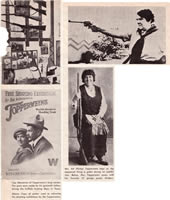 Ad
was given to bragging a bit after watching his idol that he would
someday break the Doc's record. Later when Captain Bartlett became
the king of the tossed targets, Ad boasted that someday he would
beat the Captain's mark, too. Ad
was given to bragging a bit after watching his idol that he would
someday break the Doc's record. Later when Captain Bartlett became
the king of the tossed targets, Ad boasted that someday he would
beat the Captain's mark, too.
The world's marksmanship record was a long cry, however, from
Ad's job in a San Antonio crockery shop. There he doubtless could
have gotten a lot of target practice if the proprietor had been
willing, but dusting instead of smashing crockery was a pretty
dull job for a young boy with a gun and Ad finally quit. He didn't
seem to progress much farther toward his quest of a world's marksmanship
record when he landed a job as a newspaper cartoonist with the
San Antonio Daily Express. The new job, however, did give him
funds for practice ammunition and though he didn't realize it
at the time, his talent for drawing was later to be transferred
from pen to the sight end of his rifle and gain him an international
audience for his cartooning artistry.
Shortly before he was twenty Ad was booked as local talent into
a San Antonio theater. The theater's manager George Walker was
so impressed by Ad's marksmanship that he paid Ad's expenses to
New York, hoping to place Ad on the vaudeville circuit.
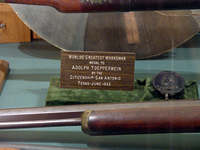 New
York City, and vaudeville everywhere for that matter, had nearly
as many trick and fancy shooters as it did banjo players. The
jaundiced-eyed vaudeville bookers who refused to follow a banjo
act with a banjo act, were unimpressed by the Texas triggerman
who was just another would-be Keith's circuit target trouper to
them and no more unique than a trained seal. New
York City, and vaudeville everywhere for that matter, had nearly
as many trick and fancy shooters as it did banjo players. The
jaundiced-eyed vaudeville bookers who refused to follow a banjo
act with a banjo act, were unimpressed by the Texas triggerman
who was just another would-be Keith's circuit target trouper to
them and no more unique than a trained seal.
Topperwein and his potential manager, Walker, gambled their last
few dollars and persuaded a booking agent for the B. F. Keith
vaudeville circuit to accompany them at their expense to Coney
Island. Up and down the shooting gallery lanes at Coney, Topperwein
proceeded to blow dime after dime's worth of ammunition blasting
every clay pipe, duck, glass ball in each of the galleries in
succession. Within fifteen minutes his amazing marksmanship had
gathered a traffic-jamming throng as the Pied Piper of Triggerdom
proceeded to temporarily bankrupt each shooting pitch in turn.
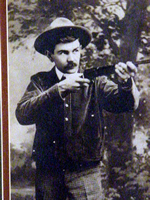 Finally
the word spread throughout the whole arcade area and the galleries
still to be tested by Topps closed their doors. The Keith's agent
agreed that Topp's skill was a bit more unique than ball balancing
on a seal's nose and that Ad's trigger finger held more audience
lure than a banjo pick. Topperwein's professional career was under
way. Finally
the word spread throughout the whole arcade area and the galleries
still to be tested by Topps closed their doors. The Keith's agent
agreed that Topp's skill was a bit more unique than ball balancing
on a seal's nose and that Ad's trigger finger held more audience
lure than a banjo pick. Topperwein's professional career was under
way.
For the next two years Topps filled in at minstrel shows and did
his stint of on-stage marksmanship along with trained dog acts
and jugglers until the greater freedom of shooting expression
was offered to him as a star with the Orrin Brothers Circus. For
the next eight years, he was featured under the canvas in nearly
every state in the country as well as in Mexico. Twice south of
the border Topps extended his magical touch on the trigger to
"miracles."
On one occasion a local Mexican police official asked Topps to
shoot at some silver coins for souvenirs. The chief tossed three
silver pesos into the air in rapid succession. Ad scored three
hits before the coins reached the ground, winging the bent currency
out of the local bull ring. Unknown to Ad at the time, a poverty-stricken
peon had been praying for help. As she sat just outside the adobe
walls of the local amphitheater, gazing heavenward and unclasped
her weathered hands, a peso dropped into her outstretched palm.
Another coin jingled to the pavement at her feet. Her prayers
had been answered by the miracle performer Topperwein.
 During
another barnstorming stint on the bull ring circuit, Ad broke
one of his cardinal safety rules. This was the only time during
his entire shooting career that Ad fired at a distant target without
checking first to be sure no one was in the vicinity of his firing.
The circus troupe, en route between performances, was passing
an apparently abandoned mission a hundred yards distant on a hillside.
One of the members of Ad's party challenged him to hit a bell
partially obscured in the mission tower. Ad compensated for what
he considered would be the trajectory of his .22 short for the
distance. He fired and missed. Instinctively he corrected for
his second shot and the bell pealed. Ad followed up with four
more shots and the bell chimed rhythmically. Unknown to Ad the
clapper of the bell had long been missing. The tiny church's parishioners
were too poor to replace it and had long before become resigned
to their muted church tower. Word of the miracle of the ringing
of the clapper less bell spread rapidly. Within days a tremendous
revival of interest occurred in the local church. Pilgrimages
were formed and the long impoverished mission gained needed financial
help. During
another barnstorming stint on the bull ring circuit, Ad broke
one of his cardinal safety rules. This was the only time during
his entire shooting career that Ad fired at a distant target without
checking first to be sure no one was in the vicinity of his firing.
The circus troupe, en route between performances, was passing
an apparently abandoned mission a hundred yards distant on a hillside.
One of the members of Ad's party challenged him to hit a bell
partially obscured in the mission tower. Ad compensated for what
he considered would be the trajectory of his .22 short for the
distance. He fired and missed. Instinctively he corrected for
his second shot and the bell pealed. Ad followed up with four
more shots and the bell chimed rhythmically. Unknown to Ad the
clapper of the bell had long been missing. The tiny church's parishioners
were too poor to replace it and had long before become resigned
to their muted church tower. Word of the miracle of the ringing
of the clapper less bell spread rapidly. Within days a tremendous
revival of interest occurred in the local church. Pilgrimages
were formed and the long impoverished mission gained needed financial
help.
Despite his success in both vaudeville and circus, Ad's ambition
to gain the world's marksmanship title had not been fulfilled.
His interest had even waned somewhat as his performances became
monotonously mechanical. It is hard to imagine a Toepperwein shoot being
“monotonous” to anyone who admired great shooting skills.
The exhibition which he performed is outlined in the following poster from the early 1900’s.
Some people wonder exactly what shots Ad Toepperwein did in his exhibitions. An early 1900’s poster entitled “Ad. Toepperwein, THE FAMOUS TEXAS RIFLE SHOT IN HIS WONDERFUL EXHIBITION OF EXPERT MARKSMANSHIP” listed a program of 45 feats:
POSITION SHOTS:
- Shooting from the right shoulder.
- Shooting from the left shoulder.
- Shooting, using the right hand only.
- Shooting, right arm extended.
- Holding rifle upside down.
- Holding rifle side ways.
- Shooting from the hip.
- Shooting backwards between legs.
- Shooting backwards between legs kneeling down.
- Shooting backwards laying on back.
- Bridge shot; bending over, resting only on head and feet. (Not as easy as it looks.)
- Shooting backwards, bending over table.
- Shooting backwards, bending under table.
- Shooting backwards with mirror.
- Shooting backwards laying down with mirror.
- Shooting standing directly on the head.
- Fast shooting at target, 16 shots in 10 seconds.
THE HUMAN TARGET.
- Putting 10 bullets into the bull’s eye of paper target held in the hand of assistant.
- Shooting a hole through the ace of hearts held in the hand of assistant.
- Shooting at and cutting a oplaying card held edge ways by assistant. (A pretty shot.)
- Extinguishing a parlor match held between thumb and fore finger of assistant.
WING SHOOTING
Objects Thrown in the Air
- Breaking glass balls in the air.
- Shooting at and hitting a baseball with 2 bullets while in the air.
- Lightning double shot; hitting two balls thrown into the air at the same time.
- Breaking balls thrown up by the shooter.
- Shooting balls thrown away from the shooter.
- Hitting a ball thrown over the shooter’s head from behind. (A hard shot.)
- Shooting a potato thrown directly at the shooter. (Considered by Dr. Carver as one of the most difficult shots with the rifle.)
- Cross shot; without a doubt the hardest of all snap shots, hitting an object thrown directly across in front of the shooter.
- Laying the rifle on the ground, picking it up after ball is thrown shooting and breaking ball before it strikes the ground.
- Throwing balls up behind the shooter turning and breaking them.
- Facing the target, turning completely around after target is thrown and hitting it while in the air.
- Shooting walnuts, marbles, pennies and other small objects.
- Shooting holes through silver coins.
- Shooting apples and potatoes, showing the peculiar effect a bullet has on these targets.
- Shooting oranges. If struck in the center, the orange will entirely disappear.
- Shooting oranges wrapped in paper. When struck the orange disappears, leaving the paper floating in the air.
- Breaking 10 balls in rapid succession, showing how fast a Winchester rifle can be fired successfully.
A FEW SHOTS WITH THE PISTOL.
- Shooting with right hand.
- Shooting the pistol held up side down.
- Shooting backwards over chair.
- Shooting backwards laying down.
- Shooting backwards between legs.
- Shooting backwards using looking glass.
- Breaking balls thrown in the air, using pistol and single bullets.
Shooting from a bicycle, balls thrown in the air by the shooter and breaking while riding at full speed.
Then in 1901 he was offered and accepted
a contract with the Winchester Repeating Arms Company. He gave
up his free-lance demonstrations to become a contract exhibition
shooter. At 91, the venerable champion looked back over the long
trail with fond nostalgia. "I'd do it all over again if I
had the chance - but this time around I would stress even more
the importance - the vital importance - of every American boy
owning a rifle and knowing how to handle it. Working with Winchester
as exhibition marksman brought me all I ever wanted; a wonderful
wife, the world's rifle shooting championship, travel, good friends
and a good living."
The dearest wish of Ad Toepperwein's heart was "That every
American citizen in good standing shall, in accordance with Article
Two of our Bill of Rights, be allowed to keep and bear arms, and
that this Constitutional right shall not be infringed! No dictator
will ever meddle with a whole nation of marksmen."
"For proof, look at Switzerland. Every man in Switzerland
over sixteen is a trained soldier, with his rifle and marching
gear ready at a moment's notice. Even madman Hitler wanted no
part of the sharpshooting Swiss! America could be another Switzerland,
if only our lawmakers had the brains and vision to take action.
The nation's future existence may depend on it."
For nearly a year Ad did more than a creditable job demonstrating
his employer's wares, but during a visit to the New Haven plant
in 1902, he met a vivacious 18-year-old redhead, Elizabeth Servaty,
who was working as a .22 caliber cartridge assembler. Oddly enough
Topps didn't meet his future wife at the Winchester plant but
rather at the pump in the New Haven Common. A few weeks later
they married and Ad suddenly had a new incentive to strive for
even greater skill with firearms.
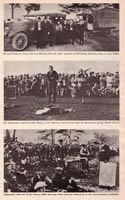 Elizabeth
had never fired a gun before her marriage but enthusiastically
joined Ad in his exhibition tours and showed no inclination to
remain just an admirer in the audience. Toepperwein described
their relationship: "Well sir, to make a short story shorter,
we hit it off right away and were married a few weeks later. It
sure pleased me when she took an interest in my shooting - most
women were scared of guns in those days, you know. I taught her
to shoot and soon after we were married Elizabeth was part of
my act on my tours, shooting one-inch pieces of chalk from between
my fingers, shooting empty shells off my fingers, and other feats
of skill. Later on, she won the title of world's champion woman
marksman." Elizabeth
had never fired a gun before her marriage but enthusiastically
joined Ad in his exhibition tours and showed no inclination to
remain just an admirer in the audience. Toepperwein described
their relationship: "Well sir, to make a short story shorter,
we hit it off right away and were married a few weeks later. It
sure pleased me when she took an interest in my shooting - most
women were scared of guns in those days, you know. I taught her
to shoot and soon after we were married Elizabeth was part of
my act on my tours, shooting one-inch pieces of chalk from between
my fingers, shooting empty shells off my fingers, and other feats
of skill. Later on, she won the title of world's champion woman
marksman."
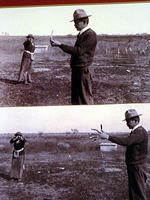 "Winchester
signed her too and we became widely "Winchester
signed her too and we became widely 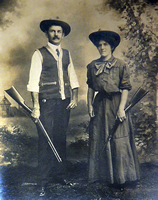 known
as the world's greatest shooting team - The Famous Topperweins.
Man, those were the days! Whole towns turned out to see us perform;
schools were closed in order that the kids might come and witness
the crack shooting exhibitions." known
as the world's greatest shooting team - The Famous Topperweins.
Man, those were the days! Whole towns turned out to see us perform;
schools were closed in order that the kids might come and witness
the crack shooting exhibitions."
From a Winchester brochure of the period:
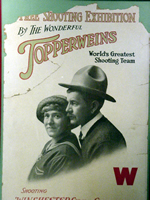
"Seeing the Topperwein shooting exhibition is like going
to a circus - a rapid succession of thrills and exciting feats,
each more unbelievable than the one before, presented to you by
this marvelous pair of shooters with rifle, pistol and shotgun
...These gun wizards put on a program full of variety from the
opening gun until the last shot is fired. They shoot at all kinds
of objects from every imaginable position - with rifle, pistol
and shotgun.
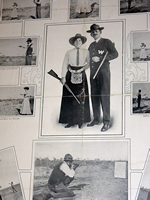 "Clay
pigeons - wooden blocks - composition balls - metal discs - marbles,
etc; even apples, oranges, real hen eggs - all are shattered with
different types of guns. Sometimes two- three -four-and even five
targets are in the air at the same time, only to be broken before
they fall back to mother earth." "Clay
pigeons - wooden blocks - composition balls - metal discs - marbles,
etc; even apples, oranges, real hen eggs - all are shattered with
different types of guns. Sometimes two- three -four-and even five
targets are in the air at the same time, only to be broken before
they fall back to mother earth."
It has always been a debatable question as to which of the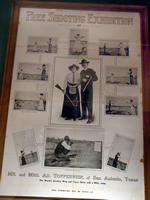 Topperweins is the better shot, Mr. or Mrs. While both do the
most remarkable shooting stunts, each has a few tough ones which
the other hesitates to try, so it is up to you to come and see
for yourself. All America came to see for itself - and the friendly
family argument was still unresolved at Mrs. Elizabeth (Plinky)
Topperwein's death in 1945. When the question was posed to Ad,
he responded: "Well," he grinned, "like the booklet
says, I was best at some feats and she was best at others. Reckon
it was a toss-up between us."
Topperweins is the better shot, Mr. or Mrs. While both do the
most remarkable shooting stunts, each has a few tough ones which
the other hesitates to try, so it is up to you to come and see
for yourself. All America came to see for itself - and the friendly
family argument was still unresolved at Mrs. Elizabeth (Plinky)
Topperwein's death in 1945. When the question was posed to Ad,
he responded: "Well," he grinned, "like the booklet
says, I was best at some feats and she was best at others. Reckon
it was a toss-up between us."
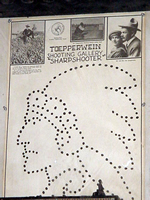 "I'll
tell you this: She could shoot smoke-rings around Annie Oakley
or any other woman marksman who ever lived! Let me give you just
a few of her records: Her best pistol score: one hundred consecutive
shots fired into a five-inch diameter spot at 25 yards. Best rifle
score on flying targets was 1460 straight hits on 21/2-inch wooden
blocks thrown into the air 25 feet from her firing position. At
Plinky's first attempt at trap shooting at the old DuPont Gun
Club in St. Loums, she scored 86 of 100. She was the first woman
ever to score a perfect 100 at clay pigeons. Later she scored
200 straight twelve times and "I'll
tell you this: She could shoot smoke-rings around Annie Oakley
or any other woman marksman who ever lived! Let me give you just
a few of her records: Her best pistol score: one hundred consecutive
shots fired into a five-inch diameter spot at 25 yards. Best rifle
score on flying targets was 1460 straight hits on 21/2-inch wooden
blocks thrown into the air 25 feet from her firing position. At
Plinky's first attempt at trap shooting at the old DuPont Gun
Club in St. Loums, she scored 86 of 100. She was the first woman
ever to score a perfect 100 at clay pigeons. Later she scored
200 straight twelve times and 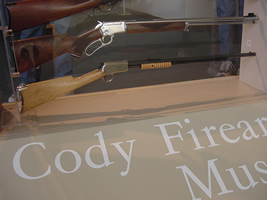 later
rung up 367 consecutive hits. "A hole-in-one in golf is just
about like hitting a hundred straight targets in shooting. My
wife Plinky did this 193 times in competition." later
rung up 367 consecutive hits. "A hole-in-one in golf is just
about like hitting a hundred straight targets in shooting. My
wife Plinky did this 193 times in competition."
Until her death in 1945, Plinky continued to be tops in women's
shooting, with either a shotgun, rifle or pistol. With a .38 Colt
at 25 yards, she once turned in a score of 497 out of a possible
500, closely approximating military timed fire. With one string
of 50 shots at a far higher rate than timed fire, she scored 492.
For more about Plinky Toepperwein, see:
http://www.traphof.org/inductees/topperwein.htm
and: http://www.traphof.org/roadtoyesterday/november2000.htm
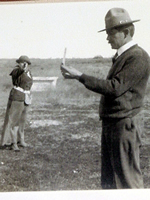
One of Ad's first large assignments for Winchester was at the
World's Fair at St. Louis in 1904. There he established his first
official record by smashing 3507 21/4 inch diameter aerial composition
targets without a miss. He began to think again of the Carver
and Bartlett records longingly and of his youthful claims that
someday he would top them. Without publicly admitting it, after
his St. Louis record, Toepp began to train for a try at the Bartlett
or Carver scores. In 1906 he shot at 20,000 2¼ inch wooden
blocks during a period of three days' shooting and scored 19,990
hits. He was sure then that all he needed was the time and proper
arrangements to make his official bid to better Carver's and Bartlett's
records.
Finally in San Antonio, on December 13, 1907, at 9:00 o'clock
in the morning, Toepps was ready to make good the boast he had
made nearly fifteen years earlier. His preparations were painstaking.
He had hired three young husky boys to toss his targets and 60,000
21/4 inch Texas white pine wooden blocks were stacked in a huge
mound at the local fair grounds. A score keeper, judge and referee
had been engaged to keep an official account of each shot.
Toepperwein on his eighty-eighth birthday in 1957 recounted the
story of the official event.
"I will admit," he said, "that when I saw this
big pile of blocks which had been delivered to the fair grounds,
I had some misgivings. Would I be able to go through with it?
And I did not sleep very well that night. Yet I was in perfect
physical condition and perfect shooting form for I had been shooting
daily for a number of years.
"Promptly at 9:00 o'clock on the 13th I fired my first shot.
I continued to shoot until twelve o'clock noon when we stopped
for an hour for lunch and a little rest for my target throwers.
We resumed the shooting again at one o'clock sharp and continued
shooting until five o'clock that afternoon. I followed this schedule
and program accurately for the next ten days from December 13th
to December 22nd, a total of 68½ hours. I did not shoot
over seven hours a day on any day, with the exception of the last
day, when I only shot for 5½ hours. I had shot up every
cartridge I had and all that I could purchase in San Antonio.
"During these ten days' shooting, I shot a total of 72,500
targets. I missed four out of the first 50,000 and nine out of
the total of 72,500."
Scores for Ad's ten days' shooting were as follows:
Date Targets shot at Number missed
Dec. 13th 7,500 0
Dec. 14th 7,000 1
Dec. 15th 7,500 0
Dec. 16th 7,000 2
Dec. 17th 8,000 0
Dec. 18th 7,000 1
Dec. 19th 7,000 0
Dec. 20th 7,000 4
Dec. 21st 8,000 0
Dec. 22nd 6,500 1
Total 72,500 9
"On the 20th," he continued, "I had my worst day
when I missed four targets. The weather during the entire ten
days was very bad, cloudy and chilly, with three days of almost
continued drizzle rain, which did not help matters much. One of
the boys offered me his raincoat, but I was afraid that it would
hamper my shooting, so I took my medicine while the spectators
stood about under umbrellas and nearby shelters.
"My equipment during the shoot consisted of three Model .03
Winchester 22 Automatic rifles and Winchester ammunition. These
rifles held ten cartridges in the magazine. In order to save time
in loading, we used loading tubes, which held ten cartridges,
and all I had to do was to open the magazine and reload the rifle
with ten cartridges. This operation only took up five or six seconds.
I loaded the guns myself and changed guns every 500 shots, because
in such rapid shooting, the barrels would be pretty hot. I had
no trouble whatsoever with the guns operating. They worked beautifully
throughout all the shoot without a single malfunction or hang-up.
The breach mechanism was cleaned every night to remove powder
residue: barrels were never touched.
"We had three men to pitch up targets, changing every 500
shots, in order to keep them from getting too tired and to make
it easier for them to throw the targets with some regularity and
speed. These targets were thrown into the air to a height of between
thirty and thirty-five feet, twenty-five feet from where I was
standing and as rapidly as possible. Although these young men
had a pretty tiresome job, there was no complaint, and they cooperated
with me in every way. They became so accurate in throwing that
I was able to shoot at practically every target they threw. It
was only in the very beginning that I refused a few of them because
they were thrown very much out of line.
"As I ran way ahead of my supposed schedule for the first
few days, we were running short of blocks toward the end, and
the boys selected the blocks that were not mutilated too much
for the rest of the score. Some of these blocks toward the end
were rather small, but I was lucky, and I don't think I missed
any on that account. The misses that I made were mostly because
my arm was so tired, and the gun seemed so heavy that I just couldn't
get it into place.
"I went through this shoot the first few days without much
discomfort. Of course I was tired, but I expected that. However,
it was a fact that all during the ten days I had very little sleep.
These blocks were so impressed on my memory that nights were simply
nightmares, and for some time afterwards I still dreamed about
shooting blocks. From the fourth day until the end.
I was in constant physical misery. My arms and shoulders ached,
the muscles of my neck pained me, and I felt like somebody had
pounded me all over the body. To add to this, the fingers and
the wrist of my right hand cramped and caused me a great deal
of pain. This was caused mostly because I have a habit of gripping
my gun very tightly with my right hand, and doing so continuously
caused the muscles of my fingers and wrist to cramp. Finally one
of the boys suggested some hot water. They made a fire and put
on a pail of water, into which I put my hand frequently to relieve
the pain. I was not the only one that was uncomfortable. My boys
that threw the targets were also suffering from stiff necks and
pains in the arms. However, they did not complain and were on
the job every minute. It was necessary for me to have a rubdown
with the hot bath every night and another one in the morning to
get myself ready for what was before me the next day.
"On the eighth day I passed Bartlett's record and the crowd
cheered wildly. Some of the spectators begged me to stop at this
point, but I was determined to continue as long as I could hold
and aim a rifle and had cartridges to shoot. Fact is, I was in
pretty sorry shape. For the last two nights I had been so stiff
and sore that Plinky (his wife) had to undress me. I couldn't
lower my arms below the waist and my shoulders were swollen and
tightened. When I flexed my arms, a sharp cramp knotted the biceps
of my right arm. By this time I had quite a beard, but I couldn't
handle a razor so got a barber to shave me."
"The ninth day was pretty much of a blur to me; still I
continued to fire away at those infernal targets. Eight thousand
of them on this next to last day and I didn't miss a one! But
I knew when I got home that night that I couldn't go on much longer.
Still I wouldn't quit. I could barely eat and I had lost so much
weight that I looked worse than any scarecrow you ever saw! My
eyes were bloodshot and no longer came to a clean, sharp focus
on the sights. Nights were filled with one long nightmare of flying
blocks and the monotonous drone of the referees, "Hit-Hit-Hit."
I found I could get my arms up to shoulder height and then could
not lower them; and once brought back to waist height, I had the
utmost difficulty in lifting them once more."
"The tenth morning the boys had to help me to the firing
line. The officials asked me if I was able to continue and I said
"Sure!" Then the blocks started sailing up and I started
shooting. I don't remember much of the morning but that huge pile
of wooden targets kept growing little by little. A hot lunch revived
me some and I went back at it again after a short rest. I fired
my last cartridge late in the afternoon, hitting the 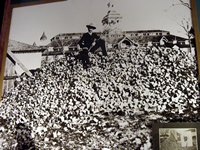 target
dead center and splitting it wide open. The boys rushed up to
grab me just as I started to black out a little and then I knew
it was all over. I would have liked to have gone on a while longer
to have rung up 75,000 targets, but I was very tired, the day
was very dark, and anyhow I was out of ammunition. So I had to
let well enough alone: 72,500 targets shot at; 72,491 hits; nine
misses. target
dead center and splitting it wide open. The boys rushed up to
grab me just as I started to black out a little and then I knew
it was all over. I would have liked to have gone on a while longer
to have rung up 75,000 targets, but I was very tired, the day
was very dark, and anyhow I was out of ammunition. So I had to
let well enough alone: 72,500 targets shot at; 72,491 hits; nine
misses.
"Although all this occurred practically fifty years ago,
it is all still very fresh in my memory, and I think these were
the most eventful days in my entire life. From the standpoint
of the number of targets shot, the number of targets hit, time
consumed and targets hit successively without a miss, this score
still stands today as the world's greatest rifle shooting performance."
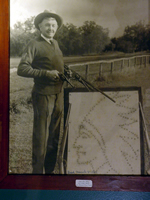 Drawing
pictures with bullets was one of Ad's most popular stunts. While
his art may not be as impressive as his 72,500 wooden block aerial
target score that was 99.9875872% perfect, the keen-eyed Texan's
bullet drawings of Uncle Sam, Sioux Indians in full war dress,
Popeye, Jiggs, cowboys and ducks with 300 rapidly fired shots
are prized possessions of gun clubs throughout the country. This
remarkable gunsman made famous the Indian-head bullet drawing.
With approximately 450 exceedingly well placed shots, the whole
of them delivered in the space of a dozen minutes, he drew the
perfect likeness of an Indian chieftain in full war bonnet regalia.
In his heyday, Topperwein Drawing
pictures with bullets was one of Ad's most popular stunts. While
his art may not be as impressive as his 72,500 wooden block aerial
target score that was 99.9875872% perfect, the keen-eyed Texan's
bullet drawings of Uncle Sam, Sioux Indians in full war dress,
Popeye, Jiggs, cowboys and ducks with 300 rapidly fired shots
are prized possessions of gun clubs throughout the country. This
remarkable gunsman made famous the Indian-head bullet drawing.
With approximately 450 exceedingly well placed shots, the whole
of them delivered in the space of a dozen minutes, he drew the
perfect likeness of an Indian chieftain in full war bonnet regalia.
In his heyday, Topperwein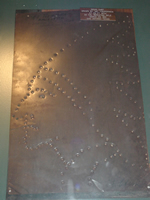 had many contemporaries, some of whom tried to emulate his Indian,
but their efforts were crude indeed compared to his bullet work.
Our Texan had been a cartoonist for a San Antonio newspaper before
he took up his guns in the Winchester cause. This artistic background
stood him in good stead when bullets replaced his pens and brushes.
had many contemporaries, some of whom tried to emulate his Indian,
but their efforts were crude indeed compared to his bullet work.
Our Texan had been a cartoonist for a San Antonio newspaper before
he took up his guns in the Winchester cause. This artistic background
stood him in good stead when bullets replaced his pens and brushes.
His shooting was by no means confined to drawing bullet pictures.
He would toss a .32-20 cartridge in the air and shoot the bullet
out of the case. He would turn the Model '03 Winchester .22 automatic
on its side, pull the trigger, and as the tiny empty was ejected,
flip the rifle to his shoulder and hit it. He tossed washers in
the air and shot through the hole in the middle. When the crowd
cried that it was a fake, he would reach in the box and bring
out a handful of washers with the holes covered with paper. The
resulting display, the bullet neatly puncturing the paper, convinced
the most doubting.
He stacked five clay pigeons on the stock of the Model 12 Scatter
gun, heaved them a dozen feet into the air, then shuffling the
slide like a demon, would break all five before any touched the
ground.
He would ask the biggest man in the crowd to come forward and
throw an egg for him. The egg would go so high some of the audience
would lose sight of it. But not Topperwein. At the very top of
its ascent the eagle-eyed exhibitionist would burst it with nothing
more lethal than a dinky ½ ounce load of No. 9 shot from
the pipsqueak .410 shotgun. He threw two clay targets, ran twenty
feet, turned a somersault, snatched up his trusty shotgun and
powdered both of 'em before either could hit the ground. Topperwein
is more than six feet tall and was as agile as a circus acrobat.
His act also included the pistol and some of his best stunts were
done with the belt gun. He would lay one six shooter over his
shoulder pointed backward. A second would be aimed forward. The
front-looking gun he aimed with his left eye, the backward pointing
weapon was aimed with a mirror and the right eye. Try it sometime.
When the two guns spoke, they always went right together and both
targets were neatly transfixed.
He had a variation to this trick which was just about as impressive.
He stood directly between two tin cans, each tin about 20 feet
distant. He would take his two six shooters, fire at both cans
at the identical moment and puncture both. This stunt involved
aiming carefully at the right-hand can, and once this aim was
good the hand, the arm and the gun had to remain absolutely fixed
while he turned his head, aimed with the left gun and once this
aim was okay, then to pull both triggers, neither weapon in the
interim having swung wide of the marks.
Many of these phenomenal feats of Ad Toepperwein and his wife
Plinky are available on VHS or DVD in the 1941 color video entitled:
"The Topps for 40 Years--Ad and Plinky" from www.showmanshooter.com
One time Toepperwein was in Bisbee, Arizona, a miner's town and
a tough spot some fifty years ago. He was doing his stuff before
a crowd of miners and, like every gathering, he had a few hecklers.
One of these kibitzers was especially obnoxious. He questioned
the validity of most of the shots which Toepperwein made. Finally
a big bumble bee came belching out of a hole at the shooter's
feet.
"If you're so damn good, let's see you hit that bee,"
the miner bellowed.
Without so much as a second's delay, our Texan swung the little
.22 auto-loader from the Indian head which he was fashioning and
fired. The bullet did not hit the bee but neatly clipped off a
wing. The insect tumbled to the ground. Without so much as a glance
our shooter swung back to his bullet drawing, the rhythm of his
firing scarcely upset. The crowd fairly howled. The heckler slunk
off to the jeers of his fellows.
If any one man proved the efficiency of the repeating cartridge
firearm, it was Ad Toepperwein who for 68½ hours averaged
more than a thousand shots an hour. In 1959, Tom Frye, a Remington
gun salesman,` girded up his loins, loaded up his Nylon 66 autos
and shooting for 14 straight days succeeded in banging away at
100,010 wooden blocks. He hit all but six. The blocks were the
same dimensions as the Toepperwein's targets but the shooting
distance appears not to have been the regulation thirty feet.
Photos of the Frye performance, which is most exemplary and in
its way most surely constitutes a record, shows the blocks were
thrown from alongside the shooter's shoulder. Toepperwein, it
will be remembered, stationed his thrower some thirty feet directly
to his front and had the targets heaved thirty feet into the air.
On January 5, 1960, Ad Toepperwein wrote the following letter
of explanation about the Frye performance:
"It has been announced by the Remington Company that one
of their shooting representatives recently shot 100,000 wooden
blocks thrown into the air, missing but six. Most wonderful shooting,
I would say, and I don't believe he could have hit more if he
had set them on a fence post. All shooting with a rifle, pistol
or shotgun is judged by distance. This is especially true when
shooting a moving object. A score with a shotgun shot at 16 yards
does not compare with one shot at twenty. And a score shot with
a rifle at 50 yards does not equal one shot at a hundred. I have
seen a great many pistol scores at pistol tournaments which produced
perfect scores at 25 yards. At the same time I have never seen
a perfect score made at fifty. In shooting my block record, which
was shot over fifty years ago, I did everything to make it official.
It was announced beforehand in all of the newspapers and was witnessed
by the public. I had a referee and judge who checked every shot
and a separate scorekeeper. The assistant who tossed up the blocks
for me stood between 25 and 30 feet in front of me, measured,
and tossed the blocks approximately 30 feet straight up in the
air. Colonel Charley Askins, noted gun editor who lives in San
Antonio, a few days ago received some photographs sent out by
Remington. He came to see me the other day just before he set
out for his African hunt and told me the pictures he has showed
the assistants standing beside the shooter and the blocks were
tossed in that manner close to the muzzle of the rifle ?- all
of which makes this an entirely different story. This shooter,
if he really shot 100,000 targets as he claimed he did, established
more of an endurance test than accuracy. I am giving you this
information so you may not form a concrete opinion of this man's
wonderful performance. Keep your powder dry. Sincerely yours,
Top "
Toepperwein followed the rules established by a group of sportswriters
of the time. In Toepperwein's words: "A group of sportswriters,
who, tired and disgusted with the conflicting claims of all the
self-styled champions, suggested that all the prominent aerial
target shooters of the times get together like sportsmen and gentlemen
and draft a set of standard rules. Well, the `sportsmen and gentlemen'
did considerable wrangling over conditions, but they did come
up with a set of rules that satisfied everybody - more or less."
The original paper read as follows:
1. The shooter could use any kind of rifle shooting a solid ball.
2. The target was to be a standard glass or composition ball (Both
were used as shotgun targets at that time).
3. The assistants tossing the targets were to stand between 25
and 30 feet in front of the shooter.
4. The targets were to be thrown into the air at a height of 25
to 30 feet.
5 There must be officials present at all matches; a judge, a referee,
and a scorer to make each match one of record.
Toepperwein continued: "Carver, Bartlett, Dr. Ruth and Annie
Oakley set their records by these rules. Ruth set the first official
world's record at aerial targets with a rifle in 1883, when he
broke 984 of 1000 glass balls. Annie Oakley tried to break his
mark in 1884, but missed by 41 shots of tying Ruth's record. Annie's
score was 943 hits out of 1000 shots." For more about Annie
Oakley, see:
http://www.traphof.org/inductees/oakley.htm
"Doc Carver told me about the rules right here in San Antonio
in 1897," Ad continued. "Fact is, he wrote 'em down
for me and advised me to follow them exactly if I wanted any marks
I made recognized as official. He called them by a fancy name:
The Carver-Bartlett Rules for Aerial Target Shooting with the
Rifle. But then Doc was a fancy fellow. .. I used the rules all
the time I was working my way up to be champion."
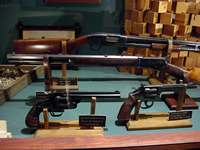
When champion of champions Ad Topperwein retired from active campaigning
for Winchester in 1951, it did not mean that he had retired from
shooting and teaching shooting to others. 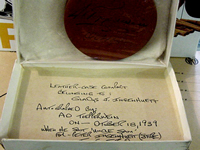 Herb Herb
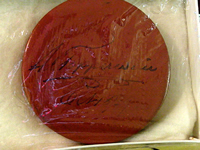 Parsons,
known as the "Showman Shooter", replaced Toepperwein
giving shooting exhibitions all over the United States. Herb had
seen Ad shoot in the 1930's at a grocery wholesale house in Somerville,
Tennessee, and decided he wanted to do the same. Herb was first
hired on as a salesman for Winchester-Western and then began Parsons,
known as the "Showman Shooter", replaced Toepperwein
giving shooting exhibitions all over the United States. Herb had
seen Ad shoot in the 1930's at a grocery wholesale house in Somerville,
Tennessee, and decided he wanted to do the same. Herb was first
hired on as a salesman for Winchester-Western and then began
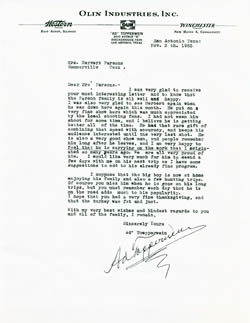 Please click on letter above for a larger
image
Please click on letter above for a larger
image. |
exhibition shooting full time after Ad Toepperwein retired. He
and Toepperwein corresponded regularly and he practiced new shots
with "the professor" when he came to San Antonio, Texas.
Herb preceded Toepperwein in death when he died in 1959 of complications
from surgery. A Parsons video (Showman Shooter) and full account
of his shooting career is available from www.showmanshooter.com
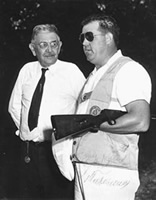
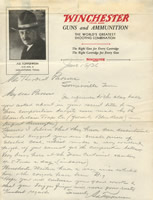
At his retirement, Ad Toepperwein was still connected with the
Winchester-Western Company in an honorary and advisory capacity.
Although temporarily sidelined by bad eyesight, he was keeping
in shape for eye surgery in the near future by walking three miles
a day and coaching the younger generation in the correct use of
firearms. At his shooting lodge at Leon Springs, Texas, twenty
miles north of San Antonio, he held free weekend classes for youths,
young business men, soldiers from nearby military bases, and anyone
else who was sincerely interested in the great American sport
of rifle and pistol shooting. The old master talked and the young
men listened intently and then went out on the firing line and
practice carefully and patiently what he had taught. Not a man
or boy who attended these weekend sessions doubted for a moment
that "Uncle" Ad would be right up there with them firing
away and cracking those aerial targets as of yore, once the eye
doctors removed those pesky cataracts from his eyes.
Adolph Toepperwein died in 1962 at the age of 93.
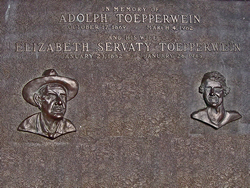
|



